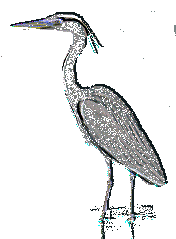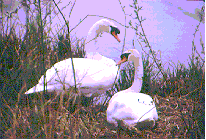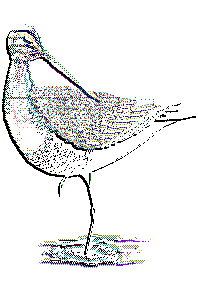 from a local stream allows the salinity of the water to be graduated
from fresh to salt water resulting in a wider range of bird species.
There are a total of 4 hides overlooking the different pools and
the saltmarsh.
from a local stream allows the salinity of the water to be graduated
from fresh to salt water resulting in a wider range of bird species.
There are a total of 4 hides overlooking the different pools and
the saltmarsh.

Superb views of waders and wildfowl with Mallard, Shelduck, Oystercatchers, Curlew, Dunlin, Redshank, Lapwing, Ringed Plover throughout the year. In summer Sandwich, Little and Common Terns join the waders. Spring and Autumn brings vast numbers of migrating birds which can include Black and Bar Tailed Godwits, Knot, Teal, Pintail, Golden and Grey Plover, Greenshank, Spotted Redshank, Whimbrel and various Sandpipers. Some of these overwinter. Offshore, Terns, Gulls, Skuas, Fulmar, Gannets and Auks can be seen in Winter, along with various sea ducks including Red Merganser Common Scoter, Red Breasted Diver, Eider and Great Crested Grebes. Also in winter many raptors visit the reserve, these include Sparrowhawk, Merlin and Peregrine Falcons.
Back at the beach head turn left into the trees, shrubs and dunes of Talacre Warren. In summer, Wheatear, Whinchat, Stonechat, Warblers, Meadow Pipit and Skylark breed along with many common resident tits and finches. These are replaced in winter by Brambling amongst the resident finch flocks,Twite and often Snow and more rarely Lapland Bunting.
The reserve offers a number of wetland habitats and a pumping system from a local stream allows the salinity of the water to be graduated
from fresh to salt water resulting in a wider range of bird species.
There are a total of 4 hides overlooking the different pools and
the saltmarsh.
from a local stream allows the salinity of the water to be graduated
from fresh to salt water resulting in a wider range of bird species.
There are a total of 4 hides overlooking the different pools and
the saltmarsh.
In addition to most of the ducks and waders at Point of Ayr, this reserve has Shoveler, Widgeon, Goldeneye, Bewick's Swan and much more impressive collections of Bar Tailed Godwit and Pintail. Raptors such Hen Harrier and Short Eared Owl visit in winter along with Merlin and Peregrine.There are numerous Canada Geese and in winter, Brent Barnacle and Greylag geese also occur. Northern finches and Buntings and Thrushes can be seen here in the winter months.
Spring and Autumn bring many birds (see Point of Ayr) but many waders such as Ruff, Golden Plovers are more frequent here. In summer, along with many common residents, Whinchat, Wheatear, Whitethroat Cuckoo and Yellow Wagtail breed.
Access to the reserve is by permit obtainable from:
Personnel Services, British Steel Corporation, Shotton Works, Deeside, Clwyd.

 On the A540 towards Neston, turn left to Burton. Beyond the village, a left
fork, Station Road, goes down to the Dee Marshes. For access to Inner Marsh Farm,
take a left turn down an untarmaced road signposted for Burton Point Farm. Parking here is
limited and the reserve is open from 9am until 9pm (or dusk if sooner), closed Tuesdays. There is a modest charge for non-members.. Spring tides bring
waders and wildfowl closer, otherwise a telescope is needed for good
viewing. A good spot for Spring and Autumn migrants, which can include
Ruff, Whimbrel, Little Stint and various Sandpipers. The occasional
Marsh Harrier has been recorded here.
On the A540 towards Neston, turn left to Burton. Beyond the village, a left
fork, Station Road, goes down to the Dee Marshes. For access to Inner Marsh Farm,
take a left turn down an untarmaced road signposted for Burton Point Farm. Parking here is
limited and the reserve is open from 9am until 9pm (or dusk if sooner), closed Tuesdays. There is a modest charge for non-members.. Spring tides bring
waders and wildfowl closer, otherwise a telescope is needed for good
viewing. A good spot for Spring and Autumn migrants, which can include
Ruff, Whimbrel, Little Stint and various Sandpipers. The occasional
Marsh Harrier has been recorded here.In summer Sedge, Reed and Grasshopper Warblers, Reed Bunting, Pipits and Wheatear breed. Winter brings northern migrant thrushes to the area along with many waders and wildfowl.

Gayton Sands
On the A540 turn left at Neston to Parkgate. Car parking is available at
the far end of Parkgate, overlooking the river front and with a telescope
good views of the intertidal mud and saltmarsh can be gained from here.
Veiwing is best on a dull day or in the mornings as a bright afternoon sun
can sillouette the birds. Apart from species already mentioned in the
previous texts, Water Rails occur here in good numbers and can be flushed
out on high spring tides.
Hilbre Islands
The Hilbre Islands are in the mouth of the Dee estuary off West Kirby, they
can be accessed at low tide by walking across the sands from the water sport
lagoon. There is a Bird Observatory and Ringing Station on the main island
which produces an annual report (see Bibliography on main page). A spectacular
range of species have been recorded here including a number of extreme
rarities. In strong gales many sea birds shelter here with Leach's Petrel
being something of a speciality.